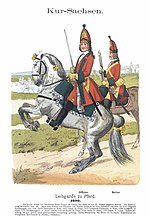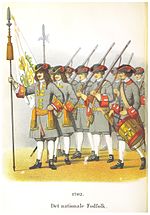List of armed forces in the Great Northern War
The list of armed forces in the Great Northern War includes all armies and navies of the warring states in the war from 1700 to 1721 .
Overview of the military in Northern Europe around 1700
The early 18th century was a time of military upheaval. Old principles that were common in 17th century warfare were replaced by new ones that lasted until the end of the century. The pace of this development was unevenly distributed. The western and northern states were more likely to have the new structures in their military systems than the eastern armed forces. This led to parallel structures in which old and new existed. Around 1700 there were standing armies that had a fixed regimental structure , as well as contingents that were only mobilized in the event of a tender . In addition to state armies, there were also temporary armies under the command of individual nobles such as in Poland and Lithuania .
Vassal states or non-sovereign principalities such as the states of the Holy Roman Empire also had their own armed forces. The Russian Cossacks and Tatar armies were outside the regular Russian army organization and had their own organizational principles and command.
There was also a technological change in the era around 1700. The pikemen were increasingly disappearing from the armies in favor of equipping muskets with bayonets . At the same time, the infantry's rate of fire increased with the introduction of lighter flintlock rifles and paper cartridges . Well that was grade regulated largely unified training, training and drill.
The Swedish army enjoyed the reputation of being the best in Europe. Swedish soldiers were feared and respected by the other armies because of their force of attack. The Russian army was fundamentally reformed under Peter I , although the innovations were not yet completed around 1700 and old structures remained present, such as the Strelitzen troop class . The Saxon Army represented the state of the art at that time, although they could not convert this militarily into victories. The Polish army had lost much of its former glory and was in constant decline. This was also evident in their combative results in battles. The Prussian army was battle-tested and used to victory in the War of the Spanish Succession and the Northern War from 1674 to 1679 . Under their King Friedrich Wilhelm I , he built the army into the most powerful in Europe. The medium-sized Kurhannoversche army was also regularly in the field and was rented to other warring states .
Cossacks, Tatars and Kalmyks mainly relied on light cavalry and small combat , which made them a constant source of danger to life and limb, especially for the civilian population.
The Danish military power focused on maintaining a strong fleet that was in no way inferior to the Swedish one. Both navies were extremely large for the underlying population size. the largest ships of the line of both fleets were actually too big for use in the Baltic Sea , as they constantly threatened to run aground in coastal areas, of which there are very many in the Baltic Sea. In addition, the willingness to take risky actions was low in both naval powers , as the loss of one or more flagships was tantamount to the loss of the balance of forces in the Baltic Sea. The Russian Baltic Fleet, for its part, arose out of nowhere after 1703 to become one of the largest in Europe. So strong that English politicians feared the loss of the Royal Navy's maritime sovereignty to Russia.
List of armies
| image | army | Affiliation | Strength | Calls | page |
|---|---|---|---|---|---|

|
Russian army | Russian tsarism | 1695: 120,000 men 1705: 121,000 men (regular troops) | Livonian-Estonian theater of war 1700–1710, Polish theater of war 1702–1706, Lithuanian-Belarusian theater of war 1702–1706, Charles XII's Russian campaign. 1707–1709, Pruth campaign 1710–1711, North German theater of war 1711–1713, Finnish-Ingermanland theater of war 1702–1714 | Nordic allies |

|
Cossack army | Formally a vassal army of the Russian tsarism | 1709: 35,000 men | Livonian-Estonian theater of war 1700–1710, Polish theater of war 1702–1706, Lithuanian-Belarusian theater of war 1702–1706, Charles XII's Russian campaign. 1707–1709, North German theater of war 1711–1713, Finnish-Ingermanland theater of war 1702–1714 | Tsarism Russia, split off a faction from 1708 to 1709 under Ivan Masepa |
| Army of the Kalmyk Khanate | Formally vassal of Russian tsarism | 1709: 10,000 men | Russian campaign of Charles XII. 1709 | Tsarist Russia | |
| Army of the Principality of Moldova | Formally vassal of the Ottoman Empire | 1710: 5000 men | Pruth campaign 1710-1711 | Russia's ally in the Russo-Ottoman War (1710–1711) | |

|
Polish Crown Army | Poland-Lithuania | 1702: 18,140 men | Polish theater of war 1702–1706, Lithuanian-Belarusian theater of war 1702–1706, Charles XII's Russian campaign. 1707-1709 | 1700–1706 Nordic Allies, 1706 to 1709 Sweden, 1709 to 1721 Nordic Allies |
| Army of the Grand Duchy of Lithuania | Poland-Lithuania | 1717: 6,200 men | Polish theater of war 1702–1706, Lithuanian-Belarusian theater of war 1702–1706 | 1700–1706 Nordic Allies, 1706 to 1709 Sweden, 1709 to 1721 Nordic Allies | |
| Army of the Lithuanian aristocratic Oginski faction | Poland-Lithuania | Lithuanian-Belarusian theater of war 1702–1706 | Nordic allies | ||
| Army of the Lithuanian noble faction of the Sapieha | Poland-Lithuania | Lithuanian-Belarusian theater of war 1702–1706 | Sweden | ||
| Army of the Confederation of Sandomir | Poland-Lithuania | 1709: 23,500 men | Polish theater of war 1702–1706 | Nordic allies | |
| Army of the Confederation of Warsaw | Poland-Lithuania | Polish theater of war 1702–1706 | Sweden | ||

|
Saxon Army | Electorate of Saxony | 1700: 18,000 men 1702: 27,000 men 1720: 30,000 men |
Livonian-Estonian theater of war 1700–1710, Polish theater of war 1702–1706, Lithuanian-Belarusian theater of war 1702–1706, North German theater of war 1711–1715 | Nordic allies |
| Danish Army | Denmark | 1700: 36,000 men | North German theater of war 1711–1715, Swedish-Norwegian theater of war 1710–1720 | Nordic allies | |
| Army of the County of Oldenburg ( Oldenburg Regiments of the Danish Army ) | Holy Roman Empire | North German theater of war 1711–1715 | Denmark | ||

|
Prussian Army | Prussia | 1713: 38,000 men | Pomeranian campaign 1715/1716 | Nordic allies since 1715 |

|
Kurhannoversche Army | Kurhannover | 1714: 17,380 men | North German theater of war | Nordic allies since 1715 |

|
Swedish army | Swedish Empire | 1697: 65,000 men 1700: 76,000 men 1707: 115,000 men 1716: 40,000 men 1718: 60,000 men 1721: 45,000 men |
Involved in all war fronts | Sweden |

|
Ottoman army | Ottoman Empire | 1710: 200,000 men | Pruth campaign | Sweden |

|
Army of the Khanate of Crimea | Vassal of the Ottoman Empire | Pruth campaign | Ottoman Empire | |
| Army of the Duchy of Holstein-Gottorf | Holy Roman Empire | 1713: approx. 3000 men | North German theater of war | Sweden |
List of fleets
| armed force | Affiliation | Calls | page |
|---|---|---|---|
| Swedish Navy | Sweden | Baltic Sea | Sweden |
| Russian Navy | Russian tsarism | Baltic Sea | Nordic allies |
| Danish Navy | Denmark | Baltic Sea | Nordic allies |
| Dutch Navy | Republic of the Seven United Provinces | Baltic Sea 1700 | Sweden |
| Royal Navy | Kingdom of Great Britain | Baltic Sea 1700, 1718–1721 | Sweden |
literature
- Georg Tessin: The regiments of the European states in the Ancien Régime des XVI. to XVIII. Century . 3 volumes. Biblio Verlag, Osnabrück 1986–1995, ISBN 3-7648-1763-1 .

